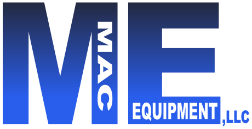Does your current construction, repair, or maintenance job involve work projects at areas higher than ground level? If so, you need the assistance of one or more professional lifts. According to the type and location of your project, you will most likely need the use of an articulating boom lift or scissor lift.
While scissor lifts can only operate upward and downward, boom lifts have the capacity to move both horizontally and vertically. Scissor lifts are equipped with larger platforms, and they can transport more weight. This enables them to move more than one worker along with the necessary materials, while boom lifts carry a single worker.
Important Considerations for Choosing Your Lift
There are multiple important aspects of your work project to consider when selecting the lift for completing your job. These aspects include the following:
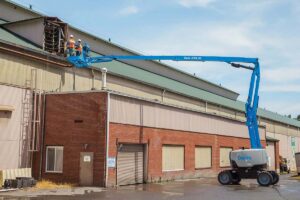
How High Do You Need to Reach?
You first need to determine the height requirements for operating lifts on your worksite. Scissor lifts can move upward to 60 feet above ground level. Yet, boom lifts are designed to reach heights equaling 210 feet above the ground when needed.
How Much Weight Do You Need to Lift?
Articulating and other boom lifts are equipped to transport 500 pounds, up to. 1,000 pounds. This makes them a good choice if your project requires lifting small to moderate-weight loads. In comparison, some scissor lift models can carry as much as 2,500 pounds.
In What Direction Do You Need to Move Workers and Materials?
If your construction or maintenance job requires only vertical transport up and down, a scissor lift is a good choice. To move a worker and materials both horizontally and vertically, however, you need to select a boom lift. Just keep in mind that scissor lifts only reach heights of 60 feet. In contrast, articulating and other boom lifts can rise from 30 to 210 feet above the ground.
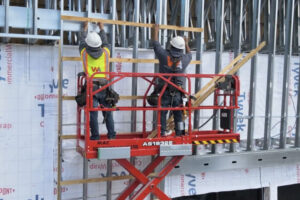 How Many Workers Are Involved in Your Project’s Lifting Tasks?
How Many Workers Are Involved in Your Project’s Lifting Tasks?
If multiple project crew members are required to complete a task using a lift, you probably need a scissor lift. Yet, if these workers must work at heights greater than 60 feet above ground level, you need to rent more than one boom lift.
This will enable two or more crew members to work together to handle this lofty task. If a group of crew members is needed to complete a higher-positioned work phase, you definitely need the use of multiple boom lifts.
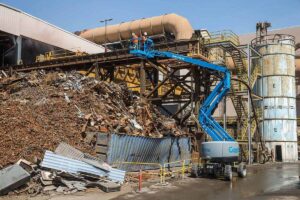
What Is the Nature of Your Job-Site Terrain?
The type of worksite terrain of a building location will determine the lift design that is needed. Take care to examine your work surfaces and areas for obstacles, corners, and cramped or irregularly shaped places. Determine whether your crew requires lift models with long-reaching arms to access some work areas.
What Is Your Budget for This Project?
Before choosing one or more boom lifts or scissor lifts for completing your project, determine your overall budget. Both of these types of lifts must have daily inspections prior to beginning work. This includes checking lifts for any fuel, oil, or battery fluid leakage, checking to ensure all functions are operating as designed, and carefully checking for any surface cracking or other damage.
The longer their hours of operation, the more thoroughly these lifts must be inspected. The extent of these necessary inspections also depends on the type of lift in use. For example, it is more costly to operate and maintain an articulating boom lift than a straight boom lift.
This is due to the fact that articulating lifts have a more complex range of motion and more joints than straight boom lifts. Both of these types of boom lifts are more costly to operate than scissor lifts.
Boom Lifts
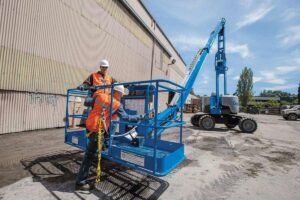
The lofty lifting capacity of many boom lift designs enables them to access the tops and roofing of many high-rise buildings. The different boom lift types, including the rough terrain and electric design, offer a wide range of versatility. The horizontal and vertical movement of these lifts makes it possible for them to perform many different tasks.
Some of these lift models offer four-wheel-drive, which increases their capacity to move over rough terrain. Boom lifts are more costly to buy or rent than scissor lifts. Yet, their wide range of mobility and capacities can make them well worth the expense.
Pros
- Can be easily maneuvered and positioned.
- Move both horizontally and vertically.
- Can access great heights.
- Are lightweight and narrow for reaching cramped spaces.
- Can often rotate workers 360 degrees when needed.
Cons
- Can have small platforms or baskets that only carry one to two workers and limited supplies.
- Are generally more expensive to buy or rent than scissor lifts.
- Are more costly to operate than most scissor lifts.
Types of Boom Lifts
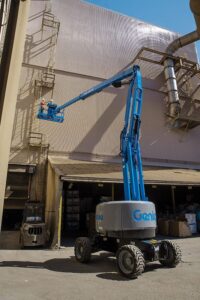 Articulating Boom Lifts: The arms of these lifts have joints or knuckles that let them bend around obstacles or corners. This is helpful when maneuvering around building exteriors or in overcrowded warehouse areas.
Articulating Boom Lifts: The arms of these lifts have joints or knuckles that let them bend around obstacles or corners. This is helpful when maneuvering around building exteriors or in overcrowded warehouse areas.- Telescopic Boom Lifts: These lift designs have straight arms that can extend and contract in a telescope fashion. They are especially good for work on bridges and in the upper areas of high-rise structures.
Scissor Lifts
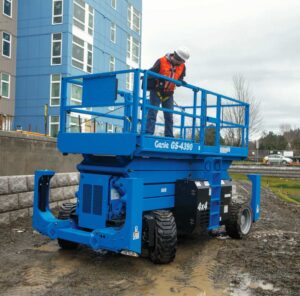
Scissor lifts have spacious aerial platforms that are flat and support braces in a crisscrossed style. The braces press together to raise the platform up vertically. Electric models are good for indoor projects like positioning warehouse inventories.
Scissor lift designs are also available in rough-terrain styles with four-wheel drive and leveling jacks. These models are ideal for traveling over rough or uneven grounds.
Pros
- Large platforms provide space for carrying multiple workers and more supplies.
- Scissor designs lend strength and stability to platforms.
- Narrow designs are helpful in cramped indoor spaces.
- Cheaper purchasing and rental rates save money on work projects.
- Good choices for work on smaller buildings without high floors.
Cons
- Are not designed to reach higher than 60 feet.
- Cannot move horizontally.
- Should be positioned adjacent to project work areas.
- Can be heavier than some boom lift models.
Types of Scissor Lifts
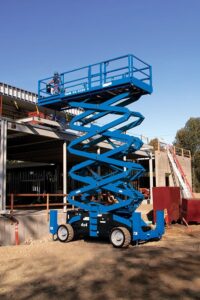
- Electric Scissor Lifts: These designs are excellent for use indoors due to their easy maneuverability. They are quiet and have zero emissions.
- Diesel Scissor Lifts: These lift models offer more power than other designs. They also have four-wheel drive and operate well on rough ground.
- Hydraulic Scissor Lifts: These lifts are powered with cylinders of hydraulic liquid and can be used easily by workers who lack extensive training.
- Rough Terrain Scissor Lifts: These rugged lift models are designed for safe, secure operation on uneven, dry outdoor surface types, including packed dirt. However, they work best in areas that are relatively flat, without slopes.
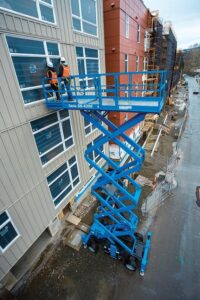 Boom lifts and scissor lifts are available in different designs to accommodate varied work project needs. The lift type and model that you select will be based on the specific needs of your work tasks. If you need a lift with vertical movement for work not higher than 60 feet, a scissor-style lift will be a good choice.
Boom lifts and scissor lifts are available in different designs to accommodate varied work project needs. The lift type and model that you select will be based on the specific needs of your work tasks. If you need a lift with vertical movement for work not higher than 60 feet, a scissor-style lift will be a good choice.
Yet, if you need a lift for construction, maintenance, or repairs on a high-rise structure, you should select an articulating boom lift. This will provide high-level, horizontal, and vertical mobility for completing your project.
